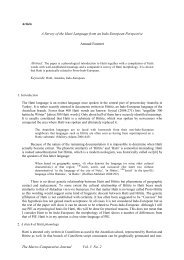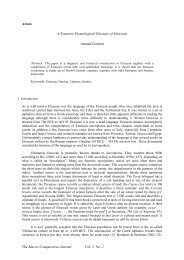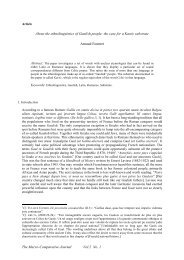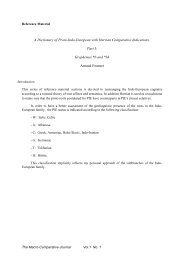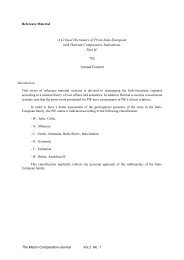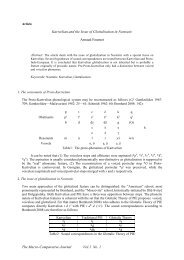The Kassite Language In a Comparative Perspective with
The Kassite Language In a Comparative Perspective with
The Kassite Language In a Comparative Perspective with
Create successful ePaper yourself
Turn your PDF publications into a flip-book with our unique Google optimized e-Paper software.
<strong>The</strong> <strong>Kassite</strong> <strong>Language</strong><br />
and toponyms are recorded in these regions according to these early sources. Several<br />
suspected <strong>Kassite</strong> names are recorded in Ur III economic documents from southern Babylonia,<br />
but it is not known where these persons come from. Cf. (Zadok 1987:16 and 1993:224 sq).<br />
− <strong>The</strong> earliest attestation of a person <strong>with</strong> a <strong>Kassite</strong> name in Babylonia is from Rīm-Sīn I’s 53rd<br />
year (1770 BCE). <strong>The</strong> <strong>Kassite</strong>s first appear as a political factor in Babylonia in 1742 (or 1741)<br />
BCE, when they were opposed by both Samsiluna and Rīm-Sīn I’s (Stol 1975:44-59).<br />
<strong>The</strong>reafter, <strong>Kassite</strong> groups and individuals are recorded in northern Babylonia especially<br />
around Sippar Yahrurum. Cf. (Zadok 1987:17sq), (De Sme 1990), (De Graef 1998:5sq),<br />
(Pientka 1998:257sq), (Sassmannshausen 2000:415 sq).<br />
− A terminus post quem for the <strong>Kassite</strong>s’ penetration into the Middle Euphrates region and<br />
Upper Mesopotamia in general can be deduced from the absence of <strong>Kassite</strong> names in the rich<br />
documentation from early Old Babylonian Mari, Tuttul, Tall Lēlān, and Chaghar Bazar. This<br />
absence compared <strong>with</strong> the hypothetical existence of <strong>Kassite</strong> names in some documents from<br />
Old Babylonian Susa may strengthen the case for a (north-) eastern origin of the <strong>Kassite</strong>s.<br />
− Kings <strong>with</strong> <strong>Kassite</strong> names appear on the middle Euphrates during the 17th century BCE.<br />
Agum who received envoys of the king of Halaba (= Aleppo) in his encampment was perhaps<br />
a contemporary of Samsiluna. Cf. (Podany 2002:49). Kaštiliašu of Terqa was probably a<br />
contemporary of Abi-Ešuh (1711-1684 BCE). Cf. (Podany 2002:43sq), (Charpin 1995).<br />
<strong>The</strong>re is good reason for supposing that <strong>Kassite</strong>s were once neighbors of some <strong>In</strong>do-European<br />
peoples or that they may even have included an <strong>In</strong>do-European component. <strong>The</strong>ir pantheon shares<br />
some affinities <strong>with</strong> the <strong>In</strong>do-Iranian one. Cf. (Bloomfield 1904), (Balkan 1986:8), (Eilers 1957-<br />
58:136 ad sūrya-). <strong>The</strong>y could purchase land and act as officials especially when it comes to horse<br />
breeding (Heinz 1995:167), which clearly points at an <strong>In</strong>do-Iranian connection. As a matter of fact the<br />
<strong>Kassite</strong> words which made their way into Akkadian are mainly from the realms of horse breeding and<br />
chariot building. This is reminiscent of what happened in the north in Mittanni and Hittite kingdoms.<br />
<strong>The</strong> impact of an immigrating <strong>In</strong>do-Iranian group is indicated by a small number of terms but <strong>with</strong> a<br />
distinct linguistic and cultural significance. <strong>The</strong>se include šuriias ‘sun god’ < <strong>In</strong>do-Aryan *sūrya, and<br />
possibly the personal name Abi-rattaš, if this name really involves the <strong>In</strong>do-Iranian term *ratha<br />
‘chariot’, thereby reflecting the new technology of warfare brought to the Near East by the <strong>In</strong>do-<br />
Iranian intruders.<br />
It appears that on the whole most <strong>Kassite</strong>s were rather well integrated in the Babylonian social<br />
structure (De Smet 1990:10) and they contributed to the general continuation of Babylonian<br />
civilization on which they had little if any cultural impact.<br />
2. <strong>The</strong> <strong>Kassite</strong> language<br />
<strong>The</strong> oldest stage of the <strong>Kassite</strong> language is scantily known from a few documents: a single tablet<br />
containing a fragment of a <strong>Kassite</strong> vocabulary and a list of <strong>Kassite</strong> names <strong>with</strong> their Akkadian<br />
equivalents. Late Akkadian provides more than a hundred items of <strong>Kassite</strong> origin, of which about 10<br />
percent are divine names. <strong>The</strong>re is no continuous attested text written in <strong>Kassite</strong>. <strong>The</strong> number of<br />
<strong>Kassite</strong> words is fairly limited: slightly more than 60, referring to specialized semantic fields: (horse)<br />
colors, parts of chariot, irrigation terms, plants and titles. About 200 additional formatives can be<br />
retrieved from the numerous anthroponyms, toponyms, theonyms and horse names used by the<br />
<strong>Kassite</strong>s (Cf. NPN, Balkan 1954 and Jaritz 1957). Traces of <strong>Kassite</strong>s in later Iranian are very few: for<br />
instance, Kašgān, Kašakān, possibly ‘land of the <strong>Kassite</strong>s’ in Iran (Eilers 1957-58:135).<br />
<strong>The</strong> name of the <strong>Kassite</strong>s is known from several sources:<br />
− and (?) which seems to be the native pronunciation,<br />
<strong>The</strong> Macro-<strong>Comparative</strong> Journal Vol.2 No. 1 2



